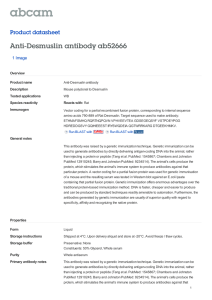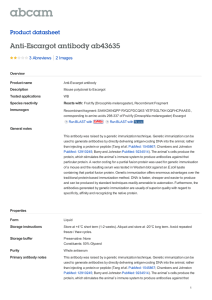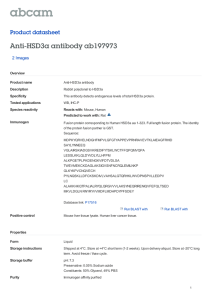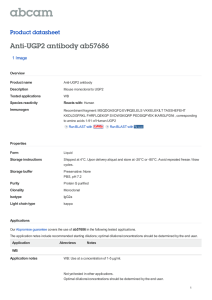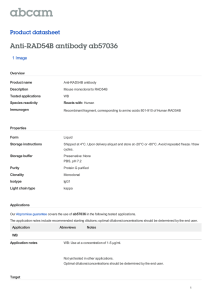Anti-IKB beta antibody ab52775 Product datasheet 1 Image
advertisement
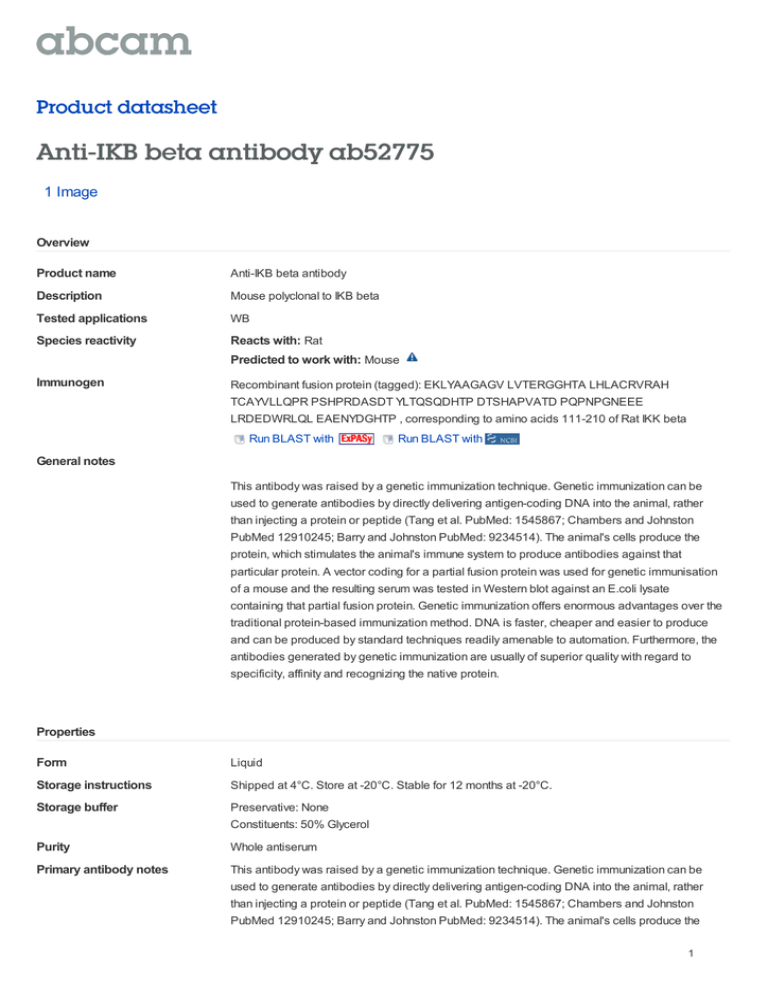
Product datasheet Anti-IKB beta antibody ab52775 1 Image Overview Product name Anti-IKB beta antibody Description Mouse polyclonal to IKB beta Tested applications WB Species reactivity Reacts with: Rat Predicted to work with: Mouse Immunogen Recombinant fusion protein (tagged): EKLYAAGAGV LVTERGGHTA LHLACRVRAH TCAYVLLQPR PSHPRDASDT YLTQSQDHTP DTSHAPVATD PQPNPGNEEE LRDEDWRLQL EAENYDGHTP , corresponding to amino acids 111-210 of Rat IKK beta Run BLAST with Run BLAST with General notes This antibody was raised by a genetic immunization technique. Genetic immunization can be used to generate antibodies by directly delivering antigen-coding DNA into the animal, rather than injecting a protein or peptide (Tang et al. PubMed: 1545867; Chambers and Johnston PubMed 12910245; Barry and Johnston PubMed: 9234514). The animal's cells produce the protein, which stimulates the animal's immune system to produce antibodies against that particular protein. A vector coding for a partial fusion protein was used for genetic immunisation of a mouse and the resulting serum was tested in Western blot against an E.coli lysate containing that partial fusion protein. Genetic immunization offers enormous advantages over the traditional protein-based immunization method. DNA is faster, cheaper and easier to produce and can be produced by standard techniques readily amenable to automation. Furthermore, the antibodies generated by genetic immunization are usually of superior quality with regard to specificity, affinity and recognizing the native protein. Properties Form Liquid Storage instructions Shipped at 4°C. Store at -20°C. Stable for 12 months at -20°C. Storage buffer Preservative: None Constituents: 50% Glycerol Purity Whole antiserum Primary antibody notes This antibody was raised by a genetic immunization technique. Genetic immunization can be used to generate antibodies by directly delivering antigen-coding DNA into the animal, rather than injecting a protein or peptide (Tang et al. PubMed: 1545867; Chambers and Johnston PubMed 12910245; Barry and Johnston PubMed: 9234514). The animal's cells produce the 1 protein, which stimulates the animal's immune system to produce antibodies against that particular protein. A vector coding for a partial fusion protein was used for genetic immunisation of a mouse and the resulting serum was tested in Western blot against an E.coli lysate containing that partial fusion protein. Genetic immunization offers enormous advantages over the traditional protein-based immunization method. DNA is faster, cheaper and easier to produce and can be produced by standard techniques readily amenable to automation. Furthermore, the antibodies generated by genetic immunization are usually of superior quality with regard to specificity, affinity and recognizing the native protein. Clonality Polyclonal Isotype IgG Applications Our Abpromise guarantee covers the use of ab52775 in the following tested applications. The application notes include recommended starting dilutions; optimal dilutions/concentrations should be determined by the end user. Application WB Abreviews Notes 1/1000. Target Function Inhibits NF-kappa-B by complexing with and trapping it in the cytoplasm. However, the unphosphorylated form resynthesized after cell stimulation is able to bind NF-kappa-B allowing its transport to the nucleus and protecting it to further NFKBIA-dependent inactivation. Association with inhibitor kappa B-interacting NKIRAS1 and NKIRAS2 prevent its phosphorylation rendering it more resistant to degradation, explaining its slower degradation. Tissue specificity Expressed in all tissues examined. Sequence similarities Belongs to the NF-kappa-B inhibitor family. Contains 6 ANK repeats. Post-translational modifications Phosphorylated by RPS6KA1; followed by degradation. Interaction with NKIRAS1 and NKIRAS2 probably prevents phosphorylation. Cellular localization Cytoplasm. Nucleus. Anti-IKB beta antibody images 2 All lanes : Anti-IKB beta antibody (ab52775) at 1/1000 dilution Lane 1 : a total protein extract from E coli with 50ng to 100 ng of a tagged fusion protein of an irrelevant antigen. Lane 2 : a total protein extract from E coli with 50ng to 500ng of the antigen (tagged antigen fusion protein) Western blot - IKB beta antibody (ab52775) Lysates/proteins at 20 µg per lane. Secondary Rabbit anti-mouse IgG + IgM, (H+L) horseradish peroxidase at 1/5000 dilution Observed band size : 38 kDa Please note: All products are "FOR RESEARCH USE ONLY AND ARE NOT INTENDED FOR DIAGNOSTIC OR THERAPEUTIC USE" Our Abpromise to you: Quality guaranteed and expert technical support Replacement or refund for products not performing as stated on the datasheet Valid for 12 months from date of delivery Response to your inquiry within 24 hours We provide support in Chinese, English, French, German, Japanese and Spanish Extensive multi-media technical resources to help you We investigate all quality concerns to ensure our products perform to the highest standards If the product does not perform as described on this datasheet, we will offer a refund or replacement. For full details of the Abpromise, please visit http://www.abcam.com/abpromise or contact our technical team. Terms and conditions Guarantee only valid for products bought direct from Abcam or one of our authorized distributors 3
